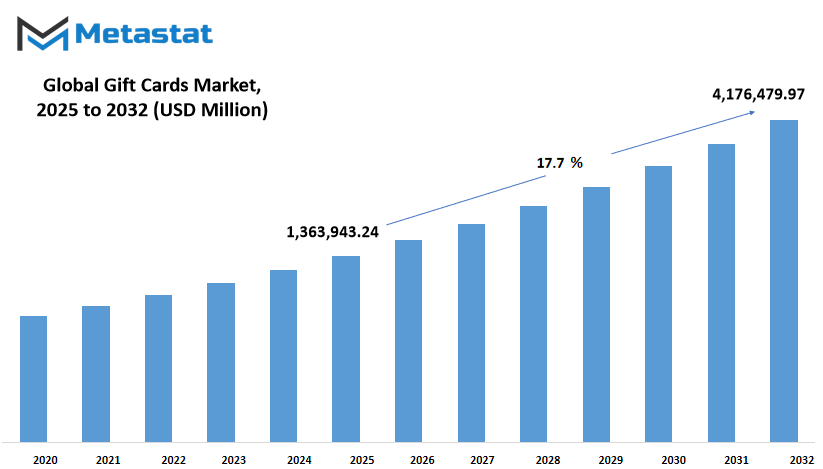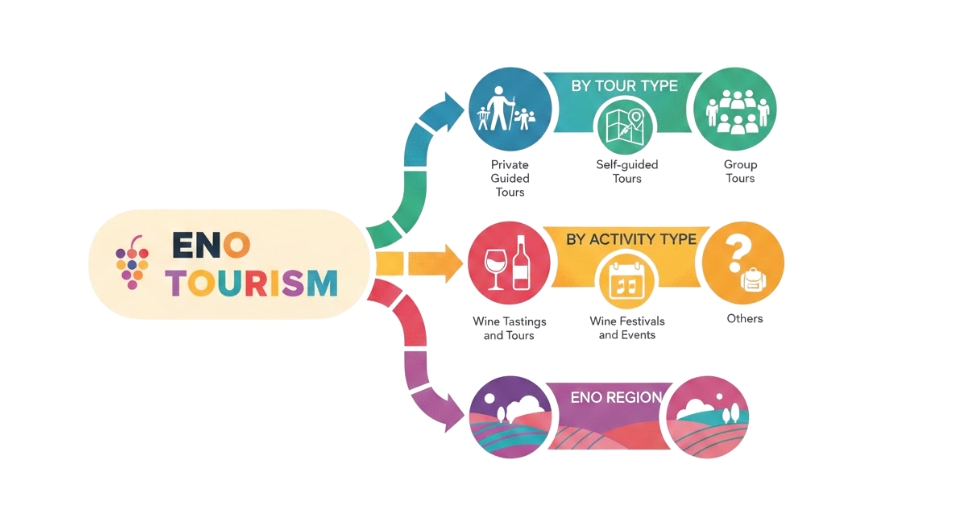MARKET OVERVIEW
The global gift cards market is observing significant momentum as online payments continue to become the preferred option for buyers across the globe. With mobile wallets and digital payment modes becoming increasingly popular, gift cards are emerging as the convenient and secure mode of payment for individuals and organizations alike. Gift cards are now picked by many on birthdays, during holidays, and other special occasions as they are easy to buy and easy to deliver. On the corporate side, businesses are turning in greater numbers to prepaid gift solutions as a component of employee incentives, customer reward programs, and holiday promotions. This transformation of corporate culture has solidified the position of gift cards as a highly valued non-cash reward, extending their application far beyond the confines of traditional retail venues.
Although this trend continues, the global gift cards market operates with some limitations. One of the significant concerns is the increasing number of scams and attempts at fraud involving gift cards, which has made others wary of using or buying them. Security and transparency concerns related to stolen card balances or theft after purchase have also been issues. Moreover, gift card systems between countries or platforms differ considerably, and it is therefore challenging to provide a uniform global experience. This in harmonization between various regions and platforms makes it more difficult for businesses to expand their gift card sales globally without encountering legal or technical issues.
Nevertheless, there are strong indications of future growth. The proliferation of online shopping channels globally has given digital gift cards the opportunities to move into mainstream. With increasing numbers of consumers opting to buy everything from groceries to gadgets online, the need for e-gifting services will only increase. Meanwhile, consumer approaches are moving towards more individual and thoughtful gift solutions. Brands that enable customers to personalize the presence, message, or amount of gift cards, redeem this expansion for specific and personal experiences. It is running businesses to be innovative and provides features that help the gift cards to look less normal and more individual.
In short, the global gift cards market, as viewed by the report presented by Metastat Insight, is being influenced by a combination of digital ease, changing consumer behavior and combining trade incentives. While issues such as standardization and fraud persist, increasing demand for online shopping expansion intersection and customized solutions means that this market is ready to move forward. As technology develops and customers' expectations change, the gift card market will probably develop with more convenient, accessible and interactive options that meet the needs of both individuals and businesses.
Global gift cards market is estimated to reach $4,176,479.97 Million by 2032; growing at a CAGR of 17.7% from 2025 to 2032.

GROWTH FACTORS
The global gift cards market is experiencing significant momentum as online transactions keep on becoming the go-to option for consumers across the globe. With the rise of mobile wallets and online payments, gift cards have become an easy and secure mode of payment for both corporate and retail customers. Gift playing cards at the moment are decided on by means of most people for birthday celebrations, gala's, and special activities as they may be easy to buy and simple to deliver. On the company side, groups are increasingly more the use of pay as you go present alternatives as an fundamental a part of employee incentives, purchaser loyalty schemes, and holiday promotions. This fashion toward company tradition has reaffirmed the location of gift cards as a beneficial non-cash reward, diversifying their use far beyond the boundaries of an ordinary retail environment.
Yet for all that momentum, the global gift cards market does have a few constraints. One of the important thing areas of concern is the increase in scams and fraud efforts associated with present playing cards, prompting a few clients to be wary of the usage of or shopping for them. The trouble of stolen card balances or publish-purchase misuse raised concerns approximately safety and transparency. Gift card structures also differ broadly with the aid of USA Or platform, so developing a continuing worldwide experience has been tough. This absence of standardization among various areas and systems makes it extra difficult for agencies to extend their present card offerings globally without encountering prison or technical hurdles.
There are, nonetheless, strong indicators of future boom. The globalization of online buying channels at some stage in the world has created new possibilities for digital present playing cards to be an well-known choice. As more clients turn to online purchasing for the whole thing from meals to electronics, the market for virtual gifting is simplest poised to grow. Meanwhile, client developments are turning in the direction of extra individualized and thoughtful gifting. Brands that allow customers to customize the layout, message, or amount of a present card are using this increasing fashion for exceptional and custom designed reviews. This is forcing businesses to think outside the box and provide features that make gift cards seem less impersonal and more personal.
Overall, the global gift cards market, as seen in the report given by Metastat Insight, is being driven by a combination of digital ease, changing consumer behaviors, and business motivations. While problems like standardization and fraud continue, the intersection of online retail expansion and increasing demand for customized solutions places this market in line for sustained advancement. As technology continues to evolve and consumer attitudes shift, the global gift cards market will continue to adapt with more secure, accessible, and engaging products that meet both individual and business demands.
MARKET SEGMENTATION
By Card Type
The global gift cards market keeps surging, driven by the evolving behaviors of consumers and the increasing need for convenient, adaptable gifting options. Out of the several types, gift cards are no longer an occasional or seasonal option but a standard element of contemporary transactions, both individual and business. It has propelled the global gift cards market into a growth cycle where card types are a key factor in determining future demand.
Among the maximum vast categories is Physical Gift Cards, contributing a excessive value of $539,172.73 million. Notwithstanding the popularity of digital options, physical cards continue to be fairly valued amongst consumers. Physical cards are easy to hand over as gifts and are sensible to use for various retail and service segments. Individuals tend to understand bodily cards as part of conventional gifting, accordingly are continually the primary alternative for birthdays, weddings, and holiday seasons. Their recognition is an indication of the aggregate of familiarity and usefulness that resonates throughout all generations.
Meanwhile, E-Gift Cards have grown in popularity because of the convenience they offer. As on line buying becomes extra not unusual, digital present cards at the moment are desired for his or her on the spot delivery and usability across e-commerce platforms. They cater nicely to ultimate-minute gifting desires and are widely used in virtual loyalty applications. The rise of smartphones and cell wallets has only boosted their usage, making them a realistic option for tech-savvy consumers who cost pace and accessibility.
Printable Gift Cards, although not as powerful, provide the perfect middle option between physical and digital. These cards can be purchased online and printed locally, giving a human touch without the shipping delay time. They're best suited for individuals who need to give something immediately but still don't want a screen-based alternative. Their scope might be little in comparison to the other two categories, but they nevertheless fill a certain need in the gifting market.
With the global gift cards market still growing, the range of types of cards guarantees that there are several alternatives to select from, based on their requirements and desires. Whether it's the familiar presence of physical cards, the immediacy of digital delivery, or the convenience of printable formats, each offers its own benefit. These options not only sell but also determine how companies engage with customers and reward loyalty in a competitive environment.
By End User
The global gift cards market, as indicated by Metastat Insight, will still experience significant changes depending on who the consumers are and how they use these cards. In terms of end user, the market is segmented into two large categories: retail institutions and corporate institutions. Retail institutions incorporate stores, supermarkets, and websites that sell gift cards as a handy and easy way for consumers to pay. Gift cards are usually availed during festive seasons, birthdays, and special events, providing customers with a convenient method of allowing the recipient to select his or her gift. The increasing culture of online shopping has also facilitated the utilization of gift cards, particularly amongst youth who are fond of having instant, mobile-driven solutions.
Corporate institutions on their side also increasingly avail themselves of gift cards as a reward to their employees and as promotional offers. As an alternative to the usual incentives, some corporations are opting for gift cards to reward staff, enhance engagement, or get new customers with campaigns. This trend represents a more utilitarian way of giving, such that the giver actually gets the bearer something useful in their own terms. With the workplaces more interested in staff welfare and customer satisfaction, this sector will receive increased focus and expansion.
The direction of the global gift cards market will be influenced by how these two end consumers respond to evolving consumer habits and technological advancements. Gift cards will need to be made available in physical and digital formats for retailers, and for corporate institutions, they might seek more tailored solutions that suit their internal objectives. Collectively, these user segments will determine the future of gift card usage, creating the global gift cards market into an adaptable and expanding arena that addresses individual and business needs. Metastat Insight report indicates this bifurcation and suggests an era where gift cards become even more integrated into everyday purchases and business tactics.
By Distribution Channel
The global gift cards market has evolved into a highly accepted way of giving, with the ability to be convenient and personalized. Individuals are increasingly opting to give gift cards instead of tangible gifts, as they allow the recipients to pick something they really need or want. As consumer behavior has changed, distribution methods have become even more vital to the global gift cards market operations. Distribution channels are at the heart of enabling gift cards to reach buyers from various platforms and lifestyles.
The global gift cards market is generally categorized into three main distribution channels: online platforms, retail outlets, and mobile apps. Each of these targets a specific audience and addresses various buying patterns. Online distribution has found growth as e-commerce has become popular across the board. Most customers currently buy gift cards from websites directly, usually as impulse buys or during special sales. Gift cards can be sent immediately over email, which is time- and effort-saving and provides an easy gifting option. With increasing internet coverage and digital payment gateways, online channels are expected to continue being a key growth driver.
Retail outlets remain an important source for delivering gift cards. Physical cards placed at checkout counters in stores, bookstores, and other retail outlets tempt impulse buyers who had no intention to buy a gift earlier. Such cards are high during festivals, birthdays, or when one wants something physical. Physical presence and prominence facilitate awareness and impulsive buying. Retail availability has also been eased by collaborations between stores and major brands, which facilitates wider reach and choices.
Mobile apps are fast turning into a popular channel, particularly for those who use technology. With increasing use of smartphones, most companies now sell gift cards through their mobile app. These apps facilitate the process, making it quickly and convenient quickly, especially when with payment purses or loyal plans. They usually include features such as balance inquiry, reminder and customization, which improves experience for the user. Since more individuals are resorting to mobile payments and shopping options, mobile apps will have more impact on how gift cards are distributed and used.
Each of these channels has unique benefits, and collectively, they make it possible for consumers to use gift cards in the form that meets their requirements. As technology develops and shopping keeps moving towards digital facility, these channels will develop and shape will shape how the global gift card market moves forward.
|
Forecast Period |
2025-2032 |
|
Market Size in 2025 |
$1,363,943.24 million |
|
Market Size by 2032 |
$4,176,479.97 Million |
|
Growth Rate from 2025 to 2032 |
17.7% |
|
Base Year |
2024 |
|
Regions Covered |
North America, Europe, Asia-Pacific, South America, Middle East & Africa |
REGIONAL ANALYSIS
The global gift cards market is distributed in various regions that contribute uniquely to its overall function. Segmentation geographically, it has North America, Europe, Asia-Pacific, South America, and the Middle East & Africa. North America consists of the United States, Canada, and Mexico. Among these, the U.S. is a dominant player because of its well-developed retail infrastructure and extensive consumer use of digital payment means. Canada and Mexico are also experiencing consistent growth, buoyed by growth in e-commerce and holiday shopping patterns.
In Europe, the gift cards market covers the United Kingdom, Germany, France, Italy, and Rest of Europe. The nations are witnessing increased use of gift cards, primarily digital, influenced by evolving consumer shopping habits and rising demand for convenient gifting. The UK and Germany are at the forefront of this trend, complemented by established online channels and technology-literate consumers. France and Italy are following, witnessing increased usage during holidays and business gifting.
Asia-Pacific is another crucial area, comprising India, China, Japan, South Korea, and others. Demand here is growing aggressively as more individuals adopt digital lifestyles. China and Japan are well-equipped digitally, and gift cards are thus a hassle-free option for personal use as well as business usage. India also is witnessing growing interest due to growing smartphone adoption and an expanding middle class, which appreciates convenience while gifting. South Korea continues to push forward with innovations in digital finance, adding momentum to the trend across the region.
In South America, nations such as Brazil and Argentina are driving the growth of the gift cards market with the rest of the region following suit. Brazil is leading with high use in urban areas underpinned by robust mobile and internet penetration. Argentina is also showing improvement as economic changes lead individuals to move toward prepaid and managed spending alternatives such as gift cards.
Finally, in Middle East & Africa, the gift cards marketis divided between the GCC Countries, Egypt, South Africa, and the rest of the region. The Gulf nations are rapidly developing an interest in gift cards, prompted by contemporary retail centers and shopper appeal for electronic forms of payment. Egypt and South Africa are also emerging as significant contributors, spurred by requirements for safe, versatile payment instruments in expanding urban markets. Other regions of the area are steadily improving, led by digital growth and retail progression.
All of these regions are bringing along their own set of circumstances that influence the use and acceptance of gift cards, which means geography plays an important role in guiding the direction of the global gift cards market.

COMPETITIVE PLAYERS
The global gift cards market, as it has been recognized in the report by Metastat Insight, continues to revolutionize the way businesses and consumers engage with today's gifting and prepaid solutions. As there is increasing demand for easy, flexible, and digital payment facilities, gift cards are no longer a seasonal or periodical gift but are a feature of daily shopping, employee incentive programs, and customer loyalty schemes. Regardless of whether they are used for customer purchases or as rewards in company incentive schemes, present cards provide an smooth way of coping with transactions without keeping coins balances or divulging financial institution records.
Retailers like Amazon.Com, Inc., Walmart Stores, and Target Corporation have been instrumental in making present cards more accessible and famous. Their structures permit customers to purchase and redeem playing cards for numerous products and services, and hence are a good option for senders in addition to recipients. Companies along with Starbucks Corporation and Best Buy Company, Inc. Have also leveraged this comfort by means of permitting clients to utilize gift cards now not only for occasional buying however additionally for normal needs, thereby making their loyalty applications greater valuable.
Digitalization has further promoted development in this arena, with technology-driven companies such as Gyft, PayPal Inc., and QwickSilver Solutions facilitating businesses and consumers becoming paperless. Mobile wallet support and seamless integration into online checkout processes make digital gift cards convenient and appealing. Blackhawk Network Holdings, Inc. and InComm are among the companies shaping strong distribution networks, making these cards accessible both online and in stores. While that is happening, businesses are aided by vendors such as Edenred Group and Givex Corporation with the provision of individually branded employee rewards or promotional programs.
In nations such as Australia, companies such as ALDI Group, Woolworths, The Good Guys Discount Warehouse (Australia) Pty Ltd, and Harvey Norman Holdings have solidified the physical and electronic presence of gift cards in supporting consistent market performance. In the same vein, in the financial services sector, American Express Company and Fiserv Inc are providing prepaid solutions customized for safe spending, with Edge Loyalty Systems Pty. Ltd. and National Gift Card Corporation providing streamlined logistics and management services to clients across the globe.
As customer demand remains inclined toward immediate, personalized, and technologically compatible options, the global gift cards market will probably experience steady growth. As firms are continually enhancing their systems and looking for new methods of incorporating personal touches or incentives into these cards, the transition from gifts to functional spending instruments will only increase. In the report from Metastat Insight, it is presented how the global gift cards market is no longer simply about seasonal trends—it's part of an evolving paradigm in how value is exchanged, stored, and spent worldwide.
Gift Cards Market Key Segments:
By Card Type
- Physical Gift Cards
- E-Gift Cards
- Printable Gift Cards
By End User
- Retail Establishment
- Corporate Institutions
By Distribution Channel
- Online
- Retail Stores
- Mobile Applications
Key Global Gift Cards Industry Players
- Amazon.com, Inc.
- Best Buy Company, Inc.
- Starbucks Corporation
- Target Corporation
- Walmart Stores
- QwickSilver Solutions
- National Gift Card Corporation
- InComm
- Gyft
- Edge Loyalty Systems Pty. Ltd.
- Blackhawk Network holdings, Inc.
- Edenred Group
- ALDI Group
- American Express Company
- Metcash
- Fiserv Inc
- Givex Corporation
- The Good Guys Discount Warehouse (Australia) Pty Ltd
- PayPal Inc
- Woolworths
- Harvey Norman Holdings
WHAT REPORT PROVIDES
- Full in-depth analysis of the parent Industry
- Important changes in market and its dynamics
- Segmentation details of the market
- Former, on-going, and projected market analysis in terms of volume and value
- Assessment of niche industry developments
- Market share analysis
- Key strategies of major players
- Emerging segments and regional growth potential








 US: +1 3023308252
US: +1 3023308252






